JIRA Regulation and Safety Division,
Regulation Committee, Environment WG
The survey report of
environmental regulation trend in the world
1. Introduction
The environmental regulations of chemical substances contained in products started with the European WEEE/RoHS Directives. Since then, many countries expanded the scope of regulations to medical devices. For example, we see the expansion into the European EuP (Energy-using Products) Directive, REACH(Registration, Evaluation, Assessment of Chemicals)regulation, Battery Directive, Chinese RoHS regulation, the U.S. regulation, the Korean waste charge system for difficult-to-dispose-of waste, IEC standards, and so on. The further expansion is forecast in the future.
From April 2007, the JIRA RoHS-WEEE WG changed its name into "Environment WG" in order to cope with the increasing applications of environmental regulations for medical devices in many countries and to actively address environmental issues. Moreover, this WG exchanged information with the JFMDA Environment Committee, Japan Category 8/9 Industries Association. The outline of the environmental regulation systems in several countries obtained by this information exchange is introduced here.
2. Introduction of main environmental regulations in the world
The main environmental regulations in the world introduced here is as follows.
| About the main environmental regulations in the world |
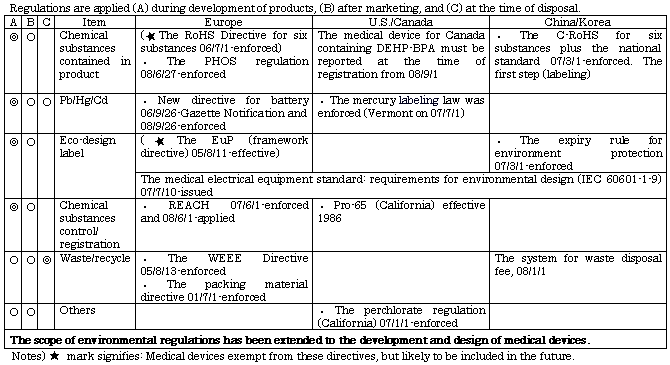 |
2.1 The outline of requirements of each law and standard
(1) EU RoHS Directive
(a) The EU law prohibits the use of six specified substances in electric and electronic products
Notes) The six substances are lead (Pb), cadmium (Cd), mercury (Hg), hexavalent chromium, polybrominated biphenyl (PBB, bromic fire retardant), and polybrominated diphenyl ether (PBDE).
(b) This RoHS Directive was enforced in July 2006. Medical devices (category 8) and monitoring/control apparatus (category 9) are not subject to this directive, as is well known. But, they proposed in December 2008 that this directive should be mandatory from January 1, 2014. This proposal is not final at present, but it is highly likely to be finalized. Countermeasures need to be prepared beforehand.
(c) EU RoHS is to be reviewed every four years. Even if an exemption is announced for any item in the final report, it will become invalid as soon as application is technically feasible. Companies should continue to make efforts.
(2) EU WEEE Directive
(a) Producer's responsibility
1) Those who produce/sell the electric and electronic products under their own brands
2) Those who import/export the products professionally to member countries
3) Those who resell, under their own brands, products produced by others
(b) Recovery recycle responsibility of wasted electric/electronic devices (including medical devices)
1) Attachment of marks of classification to wasted electric/electronic devices
2) Provision etc. of product weight information, material information, disassembly manual
(3) EU battery Directive
(a) For the purpose of environmental improvement (prohibition of hazardous material, improvement in recycling), a label must be attached to a battery and product (including medical device) containing a battery and its component. A producer must provide information for registration.
(4) EU EuP Directive
(a) Directive about the requirements for environmental design of products that use energy.
(b) Medical devices are outside of the scope of application at present, but it is likely that they will be included in the scope in the future.
(5) EU REACH regulation
(a) REACH (Registration, Evaluation, Authorization, and Restriction of Chemicals) is a new system to control chemical substances in the EU and has been effective since June 1, 2007. The actions, such as actual pre-registration, were started on and after June 1, 2008.
(b) On October 28, 2008, the European Chemicals Agency (ECHA) announced 15 kinds of substances included in candidate list of very high concern (SVHC) whose inclusion in articles should be regulated. If an article (part) used for an equipment to be placed to the European market contains an SVHC, notification and/or distribution of chemical safety-related information is required.
The number of the designated SVHCs will increase. Therefore, the responsibility will rest also upon the set maker including the medical equipment maker. As a result, it will be necessary to control every chemical substance contained in parts.
(6) EU PFOS Regulation
(a) On and after June 27, 2008, sales and the use of any products in the European Union (EU) was prohibited, if they contain more PFOS than the limit (as substance itself or ingredient of concentration exceeding 0.005 wt%).
Notes) Perfluorooctane sulfonate (PFOS): It is a kind of an organic fluorine compound. It is difficult to decompose and easy to accumulate in the body, possibly harming the liver.
(7) Chinese RoHS (Management Methods on the Control of Pollution from Electronic Information Products)
(a) The first step: Labeling Regulation
Labeling is mandatory, but use of hazardous substance is allowable. (China does not adopt EU RoHS as it is.)
(b) The 2nd step: China is preparing for the regulation of hazardous substances (which is similar to EU RoHS regulation) and mandatory CCC safety certification. For the time being, medical devices seem to be exempt from mandatory CCC safety certification.
(8) The U.S. California State Perchlorate Regulation
(a) The lithium perchlorate contained in the lithium battery corresponds to this regulation.
(b) The battery containing perchlorate more than 6 ppb (0.0000006%) (=CR type lithium battery) is regulated, whether it is used alone or incorporated in substrates (including those for medical devices). Descriptions and labeling on user manuals etc. are mandatory.
(9) The U.S. Vermont State Mercury Regulation
(a) If a product uses mercury or incorporates a part containing mercury (including a medical device using a liquid crystal panel), then it shall have a label. This regulation also requires a maker to submit a labeling plan.
(b) Unlike in other states, this regulation includes medical devices, industrial equipment and commercial equipment.
(c) The similar mercury regulation is effective in the states of Louisiana, Massachusetts etc.
(10) Canada, mandatory reporting of products containing DEHP and BPA
(a) When a medical device is destined for Canada and registered at Health Canada, it is subject to mandatory checking of whether it contains DEHP (bis(2-ethy(hexyl)phthalate) or BPA (bisphenol A). On and after September 1, 2008, the regulation was effective.
(11) South Korea, "a waste charge system for difficult-to-dispose-of waste"
(a) In order to save resources and promote recycling, they revised "the law enforcement ordinance about promotion of the reuse of resources", and enforced a waste charge system for difficult-to-dispose-of waste on January 1, 2008.
(b) If a medical device contains plastic material, then an importer must pay a charge that is proportionate to the quantity used.
(12) IEC 60601-1-9 standard for medical devices
(a) The life cycle of the product from material supply to disposal of the product has an environmental impact. In order to decrease the impact, you need to adopt material which has less environmental load and replace hazardous substances. Therefore, in order to decrease the hazardous environmental load caused by a medical device, they established the IEC standard about the requirements for environmental design (IEC 60601-1-9) in July 2007.
(b) This standard requires implementation of life-cycle assessment.
(c) Establishment of a JIS standard based on this IEC standard is under consideration.
3. Conclusion
(1) Countermeasures to be made by companies
Those who are finally responsible for the environmental regulation are the manufacturers who sell their products in the market. A big burden is required to comply with the regulations. In order to address a new regulation, such as REACH, companies need to confirm the supply chain beforehand, and prepare for compliance with regulation.
(2) When a medical device is destined for Canada and registered at Health Canada, it is subject to a mandatory check of whether it contains hazardous chemical substances. The medical device directive was revised. Labeling is required for possible patient radiation dose. As shown in these examples, environmental countermeasures are rigorously required, not only for global natural environment but also the health and safety of individual people.
(3) The laws and regulations related to the environment are becoming more severe. Japanese companies, whether big or small, must address more actively the serious issue of global warming for example, and environmental issues in general.
4. Future plan
(1) After WEEE/RoHS, many regulations such as REACH have been established and reviewed. We intend to exchange information with JFMDA Environment Committee and Japan Category 8/9 Devices Industries Association, and to continue active involvement.
(2) From April, 2009, the Environment WG will change its name into "Environment Committee" in order to cope with the increasing applications of environmental regulations to medical devices in many countries and to actively address environmental issues
(3)We must develop and sell medical devices by watching the global trend of environmental regulations. This is an essential requirement. The number of JIRA Environment WG members is gradually increasing. We hope that more members will join actively in information exchange and in the propagation of JIRA's opinion.
JIRA International Division WG
The JIRA Booth Exhibited at the 17th CHINA-HOSPEQ 2008
The China Ministry of Health (MOH) International Health Exchange Center sponsored and held the 17th CHINA-HOSPEQ 2008 (Beijing), where JIRA exhibited its booth for the third time. The JIRA booth attracted many visitors during the period of exhibition.
A feature of this CHINA-HOSPEQ 2008 is the many seminars that were held to support the exhibition. As a result, about 200 Chinese companies joined the exhibition (compared with 262 companies in 2007). Although the number of exhibitors in 2008 decreased, the number of visitors in 2008 increased compared with 22,657 recorded in 2007. (This is a comment from the sponsor).
The purposes of CHINA-HOSPEQ 2008 were as follows:
CHINA-HOSPEQ functions to facilitate appropriate distribution of medical health resources, to upgrade the equipment level of health institutes, to introduce and spread the advanced technology and to promote the development of Chinese health care. Appointed by the Ministry of Health to assess, select and show exhibits, CHINA-HOSPEQ serves the governments, consumers and enterprises by building a bridge for communication and a platform for centralized procurement. It inherits the principle that science and exhibition boosts each other.
There were 8 zones as follows.
(1) Large imaging equipment and
high-priced materials
(2) Disinfection/infection control
equipment
(3) Endoscope equipment
(4) Emergency and ophthalmology
equipment
(5) X-ray-apparatus
(6) Diagnostic-ultrasound equipment
(7) Laboratory and biological laboratory
(8) High-priced consumables
JIRA exhibited a panel to show its activities and distributed catalogs of products of member companies.
 |
| Beijing Exhibition Hall |
The contents of the exhibition of the JIRA booth are as follows.
(1) Panel exhibits
a) Introduction of the the Activity of the JIRA International Division
b) Introduction of the JIRA members companies whose product catalogs were distributed
c) Hall rayout which indicates the booths of JIRA member companies
d) Introduction of ITEM 2009
(2) Catalog exhibits
We displayed and distributed catalogs of seven JIRA members companies that manufacture related apparatus and accessories. The products included the portable X-ray-apparatus, illuminator (light box), X-ray grids, X-ray intensifying screens, X-ray film changers, full-automatic sphygmomanometers, medical phantoms, etc.
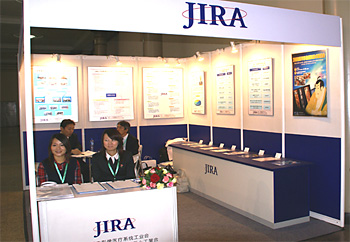 |
| Full view of the JIRA booth |
During the exhibition period, we distributed a total of 332 bags containing a catalog, a souvenir, and a JIRA introduction pamphlet.
We received the following response from the visitors to the JIRA booth.
1) Request for advertisement from a magazine .
2) Inquiries for the products and business
3) Interest in ITEM 2009
4) Inquiries for JIRA promotion in China
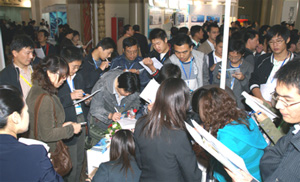 |
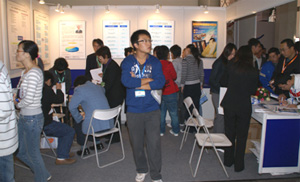 |
| The JIRA booth attracted many visitors |
The name of JIRA is getting popular every year. It is positive evidence that the JIRA booth was effective. Moreover, JIRA and China MOH have regular meetings for information exchange. These meetings and this exhibition have the synergistic effect to increase mutual understanding and trust.
JIRA International Division WG
The 60th China International Medical Equipment Fair (CMEF)
The China International Medical Equipment Fair (CMEF) is said to be the largest commercial exhibition in Asia. Since 1979, it has been held twice a year spring and autumn. It is sponsored by the China Association of Medical Devices Industry (CAMDI).
The 60th Fair was held at the International Expo Center in Suzhou City from October 29 through November 1, 2008. The total floor space of the venue was 86,000 square meters. The total booth area was 43,000 square meters. About 2,000 companies participated in the Fair.
For CMEF, JIRA exhibited its booth at the 2007 spring fair in Dalian, the 2007 autumn fair in Chengdu, the 2008 spring exhibition in Shenzhen, and this time at the 2008 autumn exhibition in Suzhou. So, this was the fourth exhibit.
The opening ceremony was held on October 29, the first day of the Fair. JIRA is one of the cooperate members of CMEF. So, its representative (shown at the far left in the photo) attended the ceremony.
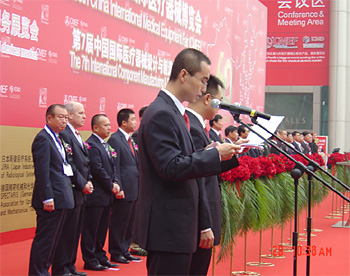 |
| The opening ceremony of the 60th CMEF |
As many as 2,000 companies exhibited. The exhibitors are about 15 times the International Technical Exhibition of Medical Imaging (ITEM) (exhibitor numeres:140) held in Japan. The JIRA booth was located in the international exhibition zone. There was also an exhibition area of large-sized equipment. In addition to these buildings, there were many halls that accommodated many small booths. These booths were occupied by Chinese companies that were grouped according to provinces.
The outline of the JIRA booth
JIRA booth is located in the international exhibition zone. The booth was 54 square meters. We displayed the panels that introduced JIRA and illustrated its international activity. We distributed JIRA pamphlets in Chinese and leaflets in English for The International Technical Exhibition of Medical Imaging (ITEM), for which JIRA is one of the co-sponsors.
We also displayed related apparatus and accessories of JIRA member companies. Six companies displayed equipment, and one company displayed its catalog. The following companies participated in this exhibition.
MIKASA GLOBE Co.,LTD
TORECK CO., LTD.
ORION ELECTRIC CO., LTD.
ViewSend Co., Ltd.
Rimage Japan Co., Ltd.
MITAYA MANUFACTURING CO., LTD.
KASEI OPTONIX, LTD. (display of catalog)
The JIRA booth was located near the entrance and in the center of the international exhibition zone, and attracted many visitors.
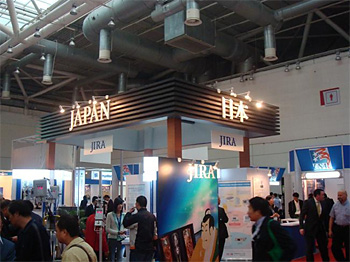 |
| The JIRA booth in the 60th CMEF |
| Number of visitors, CMEF and the JIRA booth |
 |
| |
| Occupation of visitors to the JIRA booth |
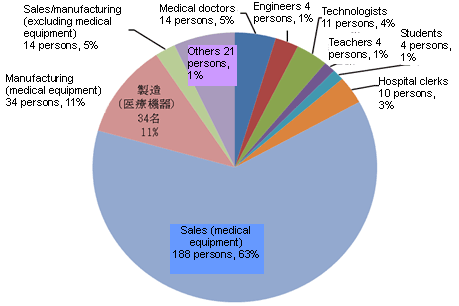 |
More than 50,000 persons visited CMEF in the period of three and a half days. The visitors to the JIRA booth was 468 . More than a half of them were sales persons of medical equipment, representing local agents. This trend shows that CMEF is not a concurrent academic exhibition, but a purely commercial exhibition (trade fair).
Participating companies receive an increasing number of inquiries according to their continual participation. Some visitors showed special interest in Japanese products. The JIRA policy for exhibition is as follows. The related products are displayed and explained at the booth. Visitors looking for large equipment are shown the panel and then guided to the booth of JIRA member companies. This style of presentation is now established. Visitors often take an interest in products of several companies. The JIRA booth received inquiries from various fields. A booth of a single company cannot receive such inquiries. JIRA can meet the needs shown by medical professionals, equipment manufactures and local agents. This is the advantage of the JIRA booth.
This CMEF is held in several cities in China. The 2009 spring fair will be held in Shenzhen from April 18 through 21, 2009.
JIRA International Division WG
The JIRA Booth Exhibited at RSNA
The 94th Technical Exhibition of Scientific Assembly and Annual Meeting of Radiological Society of North America (RSNA) was held in 2008. Every year about 60,000 persons participate from the U.S, Canada, North America, Japan and the rest of the world. It is the largest technical exhibition of scientific assembly and annual meeting of radiology.
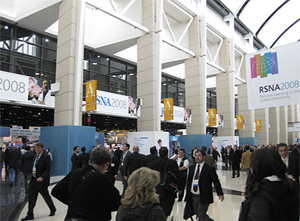 |
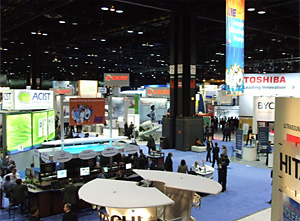 |
| Central concourse of McCormick Place |
Distant view of exhibits |
The 2008 RSNA opened on Sun. Nov. 30, though Thurs. Dec. 4 (for exhibition) and through Fri. Dec. 5 (for annual meeting) at McCormick Place, Chicago, Illinois.
According to the official RSNA announcement, about 59,000-persons enrolled (for annual meeting, exhibition etc.), and about 800 companies participated in the exhibition.
About 30 JIRA member companies displayed their own booths. Others used their U.S local subsidiaries, or overseas parent companies. In various forms of participation, JIRA member companies have joined RSNA every year since a long ago.

We used two zones as follows.
1) We displayed the panels that explained JIRA, ITEM (the largest technical exhibition of medical imaging in Japan), the statistical data about Japanese market etc. We distributed the JIRA introduction brochures at the DVD Video Zone. We advertised ITEM to attract foreign exhibitors
2) We displayed the related apparatus and accessories of JIRA member companies. Five companies displayed equipment, and three companies displayed catalogs. They were as follows.
- Engineering systems Co., Ltd.
- Orion Electrical Co., Ltd.
- Climb Medical Systems Inc.
- RIKUTOH CORP.
- MORIYAMA X-RAY EQUIPMENTS CO., LTD.
- IKEN ENGINEERING CO., LTD. (display of catalog)
- K.K.LAMTEC (display of catalog)
- NIHON MEDICAL CO.,LTD (display of catalog)
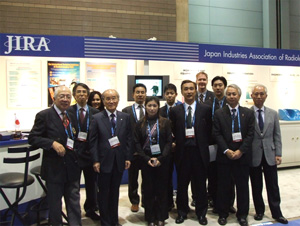 |
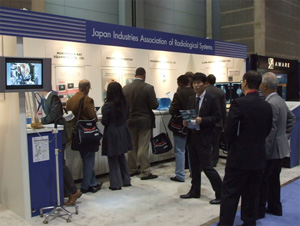 |
The JIRA Chairman Inomata
and others |
Attendance at the JIRA booth |
The JIRA booth attracted many visitors. We distributed all 350 copies of catalogs by the fourth day. At the JIRA booth, more than 400 persons registered. We received 181 positive responses and 120 replies to questionnaire (figure 1). The breakdown by regions is shown in figure 2.
As shown in figure 2, more than 50 % of visitors came from regions other than the North America. The replies to questionnaire show that RSNA is a global exhibition.
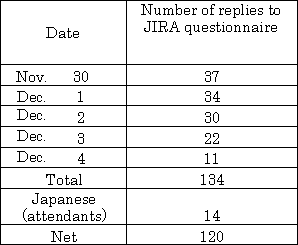 |
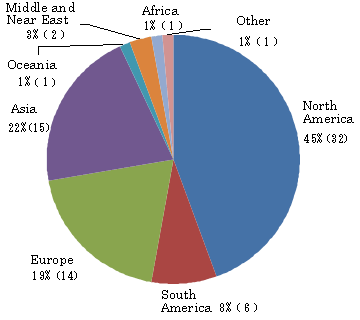 |
Figure 1. Number of replies to
JIRA questionnaire |
Figure 2. Visitors to the JIRA booth
Breakdown by regions |
Many Japanese doctors visited the JIRA booth. It was found that many foreign doctors know about JIRA and ITEM. Not only Japanese but also international paper and magazine visited us. An Indian company expressed its intension to participate in ITEM (now confirmed).
We continue to negotiate with the administrative authority. We expect that the JIRA booth at RSNA in 2008 will motivate everyone to realize the national booth, which is seen in the case of Germany and Korea.
International Division
Report on Regular Meeting with
Chinese Medical Equipment-Related Organizations
The JIRA International Division organized a mission to visit China with the purpose of our regular meeting with Chinese medical equipment-related governmental agencies and industrial associations. It was dispatched within the period of 9 - 16 October 2008, as reported below.
The mission visited:
1. International Health Exchange and Cooperation Center, Ministry of Health (MOH)
2. China Center for Pharmaceutical International Exchange, State Food & Drug Administration(SFDA)
3. Certification and Accreditation Administration (CNCA)
4. China Quality Certification Center (CQC)
5. China Association for Medical Devices Industry (CAMDI)
The visit of the mission revealed the following:
1. SFDA-related: We could not have a chance to visit the registration office of medical equipment bureau. We hope that we shall be able to visit there at the next opportunity and present frank questions from JIRA.
2. We oppose the CCC(China Compulsory Certification) certification of IT security products. We must be watchful on movements on this matter in the future.
3. Type tests are now being conducted both by SFDA registration of medical equipment and by CCC certification of CQC. We must watch when and how the tests will be unified in the future.
4. In the second phase of Chinese version RoHS regulation, China will designate products that require CCC certification. We are continuing a survey to know the time schedule of designation and the procedures of certification.
Summary of conversations with each organization is as follows.
1. Visit to Chinese Ministry of Health (MOH) International Health Exchange and Cooperation Center:
A) When the national budget is allocated, priority is given to the rural areas. However, each local autonomy selects the medical devices to be delivered to the rural areas. China does not have any centralized purchase system in the central government level.
B) MOH directly supervises 44 hospitals. Each of these hospitals makes an individual decision for the purchase of medical devices. At present, MOH does not place a blanket order for medical devices.
C) About the medical service remunerations system, planning is made by the National Development Reform Committee. This is joined by MOH to finally determine the pricing of medical devices.
D) The 11th five-year plan is posted on the web site. MOH does not review any purchasing plan of medical devices that is made by the provincial government. MOH has a purchase plan for high-priced consumables (pacemaker, catheter). MOH purchases large-type, high-priced equipment (Gamma knife, PET-CT, etc.) in a centralized purchasing system.
2. Visit to State Food & Drug Administration(SFDA), China Center for Pharmaceutical International Exchange
A) Several years ago, they started to study how to unify type tests that are conducted by both SFDA and CCC certification. They have not yet reached a conclusion. American and European companies have often complained about the duplicated tests to be conducted by both organizations.
B) SFDA’s revision notice of the product registration was exceptional. The number of registrations was too large and there was confusion within SFDA. They could not keep their promise of a 90-day deadline. As a result, this notice was issued.
C) In March 2008, they deliberated on the revision draft of the China Regulation on Supervision and Management to Medical Instruments. The Regulation will be enforced in the latter half of 2009. However, this revision will not greatly influence overseas products.
3. Visit to Certification and Accreditation Administration (CNCA)
A) About the test system of SFDA and CCC certification, they announced in the notice No. 94, 2008 as follows. A type test shall be done once, and the fee shall be paid once.
B) If the mandatory CCC safety certification will be used for mutual certification system with Japan, then product safety must be assured. Once product safety is assured, mutual certification will be feasible If mutual safety certification system will be realized between China and Japan on proper product safty control, it will be ideal.
4. Visit to China Quality Certification Center (CQC)
A) China Inspection Group Corp. was established to centralize certification procedures.
B) The government issued a new notice about CCC certification system. Verification of medical devices is rather complex. AQSIQ (General Administration of Quality Supervision, Inspection and Quarantine) and SFDA need to coordinate with each other. After completion of coordination between these two organizations, another notice will be issued
5. Opinion exchange with China Association for Medical Devices Industry (CAMDI)
A) CAMDI is preparing to establish the "Industrial Medical Equipment System Special Committee" in order to submit the opinion to the government. CAMDI is the largest industrial association of medical equipment. In addition to CAMDI, China has several smaller associations, which submit their opinion to the government. Their opinion is often accepted by the government.
B) As of October 2007, 12,530 companies produce medical equipment in China, employing about 440,000 people. The companies are concentrated in the relatively industrialized areas, such as Beijing, Shanghai, Guangdong, Jiangsu, etc. in the Chang Jiang delta area, Zhu Jiang delta area and Bo Hai Bay economic zone etc.
|

